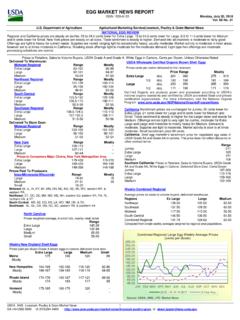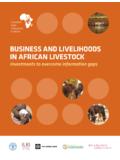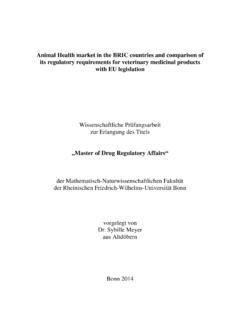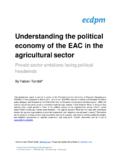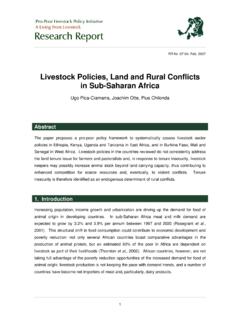Transcription of Livestock and food production in Africa: challenge …
1 Rev. sci. tech. Off. int. Epiz., 1989, 8 (3), 591-606. Livestock and food production in africa : challenge and opportunity for the national Livestock and veterinary services *. Addis A N T E N E H **. Summary: The author describes trends and difficulties in Livestock production and consumption in africa . Arguing that this production is less subsistence- oriented than commonly believed, he describes the economic objectives which play an important role in African husbandry. After a comparison of levels of production and performance with those of developed and developing nations, the role of Livestock and veterinary services in africa is examined. Improved disease control, but especially better management practices, and reduced loss and wastage, should be sought in official veterinary activities. The paper ends with a discussion of the role to be played by international organisations such as I B A R , ECA, ILRAD and ILCA.
2 KEYWORDS: africa - Animal production - Cattle - International organisations - Management - Milk - Regional cooperation - Training - veterinary services . INTRODUCTION. The performance of the Livestock sector in sub-Saharan africa over most of the last two decades has been far from impressive. The production and consumption gap for the major food commodities has widened across the continent. The major technical constraints are known and a number of solutions have been suggested t h o u g h rarely implemented. In africa the major burden of responsibility in seeking and applying technical solutions seems to rest on official Livestock and veterinary services . These services are blamed for all sorts of failures in the Livestock sub-sector, for the right as well as the wrong reasons. We must not forget that m a n y operate in a policy environment which they can neither influence nor change. However, Livestock and veterinary services must set their vision high, consonant with the great unexploited potential of the Livestock sector and the manpower resources of africa .
3 This paper presents a view of the problem, the challenge and a possible direction that the Livestock services might take to meet the challenge . The section following this introduction describes the Livestock and food situation over the past 15-20 years. * Paper prepared for the 8th Conference of the OIE Regional Commission for africa , 16-18 January 1989, Arusha, Tanzania. The views expressed herein are those of the author and should not be attributed to ILCA. ** Economist, International Livestock Centre for africa (ILCA), P . O . Box 5689, Addis Ababa, Ethiopia. 592. The third section sets out the challenge , in view of the poor past performance and some of the major technical constraints that are claimed to have hindered a better one. The fourth section considers the role which Livestock and veterinary services can play in facing u p to the challenge . The final section discusses what role regional and international organisations could play in searching for longer-term solutions.
4 A brief account of I L C A ' s programme shows that there are considerable opportunities which African Livestock and veterinary services could use to further research and development. THE SETTING. The role of the Livestock sector Direct food production in terms of meat and milk is a major activity in africa as in other developing areas. Two-thirds of the gross value of Livestock output is accounted for by meat, milk and egg production (Table I). Livestock outputs which indirectly contribute to food production (mainly crops but also recycled inputs to Livestock , cultivated animal feed, bonemeal, poultry litter) contribute the remaining one-third. The latter contribute much less to Livestock output in developed countries. TABLE I. Relative contribution of food and food -related Livestock outputs Sub-Saharan Developing Developed 1 2 2. africa countries countries Percent Meat 47 45' 53. Milk 15 15 34. Eggs 4 7 8.
5 Direct food 66 67 95. Draught 31 29 3. Manure 3 4 2. Total 100 100 1 . Sources: 1. Anteneh et al. (1988) - data for 1975. 2. FAO 1983. The State of food and Agriculture 1982. Rome - data for 1980. Disregarding non- food ( hides and skins) and minor food ( blood) items, it is estimated that the value of commodity output of Livestock in sub-Saharan africa is equivalent to 2 5 % of total food production (22). In 1983, Livestock contributed about 8% to overall calorie intakes (the world average was 16%) and 2 3 % to protein intake (world average: 34%) (12). The percent contribution of Livestock products to total calorie and protein intake increased in the majority of sub-Saharan African countries, particularly in East and Southern africa (15). 593. M a n y people, including some veterinarians and animal scientists, still believe that African husbandmen keep Livestock mainly for prestige and as status symbols or as a means of fostering cultural and social relations.
6 Most believe that African Livestock producers are highly subsistence-oriented - producing for their own consumption. There is growing evidence that economic considerations such as risk minimisation and supply security are important in influencing the way African Livestock keepers behave. D a t a from field research indicate that most African households do not, in fact, depend for their food wholly on their own farm and animal production . They usually specialise in the production of commodities in which they have a comparative advantage, selling these in order to purchase other foods. Pastoralists and holders of large herds are prominent a m o n g those who practise specialised production accompanied by exchange. They have good reasons for doing so because the m a r k e t value of a calorie of dietary energy from milk or meat is usually much higher t h a n that of a calorie from grain. At typical African domestic price ratios, ten calories in grain can be obtained by the sale of less t h a n two calories in milk or less t h a n half a calorie in meat (22).
7 In pastoral systems of dry tropical africa 50-60% of Livestock output is sold. In mixed crop/ Livestock systems in the more h u m i d and highland zones of sub-Saharan africa 35-65% of Livestock output is sold (for further discussion: 2). African pastoralists thus generate a high proportion of their cash income from Livestock in order to purchase grains. Even in production systems where Livestock provide a smaller proportion of the total value of output, the highest cash income m a y well derive from Livestock . Table II presents a range of data collected in the 1970's and 1980's. T A B L E II. Proportion of total household cash income derived from Livestock in selected production systems production Predominant Cash income system/ Ecological species derived from country zone kept Livestock (%). Pastoralists Mali Dry Cattle 96. Niger Dry Sheep/goats 96. Kenya Dry Cattle 76. Agropastoralists Kenya Dry Sheep/goats >90.
8 Mali Dry Cattle 39. Mixed farmers Ethiopia Highland Cattle 83. Northern Nigeria Subhumid Pigs/goats 56. Southern Nigeria Humid Sheep/goats 2-13. Zimbabwe Dry Cattle <4. Data sources are summarised in (2). Livestock thus provide stability in food consumption. Farmers and pastoralists sell Livestock when crops fail to generate the cash needed to purchase high-priced 594. grain. In good years they invest cash surpluses from crops in Livestock purchases or they may shift investment from one Livestock species to another (6, 26). Performance During 1963-75, except for pork, poultry and eggs, growth in Livestock output for the major commodities did not keep pace with growth in h u m a n population. Per caput output in beef, m u t t o n and goat meat as well as milk declined as did per caput consumption of these meats. Both per caput output and consumption of pork and poultry increased. The pressure to import beef and milk has intensified.
9 Table III presents average annual changes in per caput output and consumption of the major commodities, during the 1975-84 decade. Overall, the aggregate meat, milk and egg output in sub-Saharan africa grew faster during this decade t h a n during 1963-75. However, the human population also increased faster during the more recent decade ( versus 2 . 9 % p . a . ) . TABLE III. Average annual changes in per caput Livestock output and consumption, 1975-84. Per caput Commodity Output Consumption Beef Mutton \- d Goat meat Pork Poultry Total meat Cow's milk NA. Total milk N A : not available Source: ILCA (1987a). Population growth, rising income and increased urbanisation in the African countries as well as the subsidised prices of E u r o p e a n beef and dairy exports have helped to stimulate the demand for Livestock imports in sub-Saharan africa (27, 28, 20). This is particularly true in West africa where, by 1984, imports accounted for 4 5 % of total dairy consumption by volume: some countries ( C te d'Ivoire, Ghana).
10 Have become extremely dependent on dairy imports (23). Whatever increase in aggregate output has occurred is mostly attributed to increases in numbers rather than to increased yield per animal or per herd (2). africa has about 14% of the world bovine population but produces 16% and 3 % of the world beef and milk output respectively. In contrast, developed countries have about 3 0 % of the world bovine population but produce 7 1 % and 7 7 % of the world beef and milk output. The number of sheep and goats in africa constitutes 2 2 % of the world population but contributes only 17% of m u t t o n and goat meat output. The comparable figures for developed countries are 36% of population and 4 6 % of output (3, 18). 595. T h e low yields have obviously contributed little to increases in output. Table IV. compares the average productivity of African animals with those in developed and other developing countries.










